Notice I didn’t say, “Help! my students can’t write in complete sentences.” Most middle school students have the ability to write in complete sentences, so why don’t they?
It never fails. As I’m grading or giving feedback to student writing, I come across the student (or students) whose writing is one big blob. There are no paragraphs, and it is pretty much one big run-on sentence, with the exception of a period here and there. My emotions when I stare at students’ writing range from anger to annoyance to sheer confusion. How could this be what is turned in for grading?
Today’s blog post is all about intentional strategies you can use in your classroom to get students to write in complete, quality sentences.
Strategy One: Use Sentence Level Writing Activities
In order to get students to write in complete sentences, students must practice writing in complete sentences. It seems pretty simple, but this is a component I had left out of my writing instruction for years. At first I felt like practicing sentence writing would be way too easy for my middle school students. I quickly realized that students were unfamiliar with how to construct different sentence types, and this instruction was necessary over and over and over again across the school year.
Below is an example of how I structure sentence level writing instruction across my 3-week narrative writing unit, Memoir Vignettes. I use the sentence level writing instruction as a class starter during the unit.
I have committed to teaching 5 different types of sentences across a writing unit: sentences with an appositive, compound sentences, complex sentences, sentences that list items in a series, sentences that incorporate the two adjectives and one noun comma rule. I alternate between teaching about a sentence type and then having students practice writing using that sentence type. This equals out to about 5-minute increments of instruction for about 10 class days across the unit. I am still teaching a normal daily writing minilesson while taking students through the writing process to reach a final draft. The sentence level writing instruction is in addition to my regular writing instruction.
Day One: Teach About Appositive Sentences
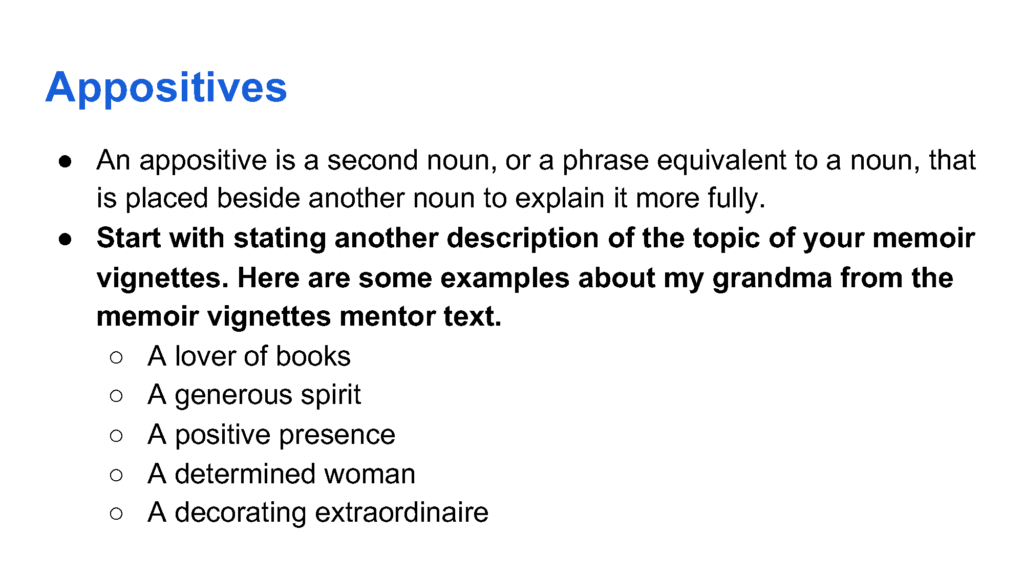
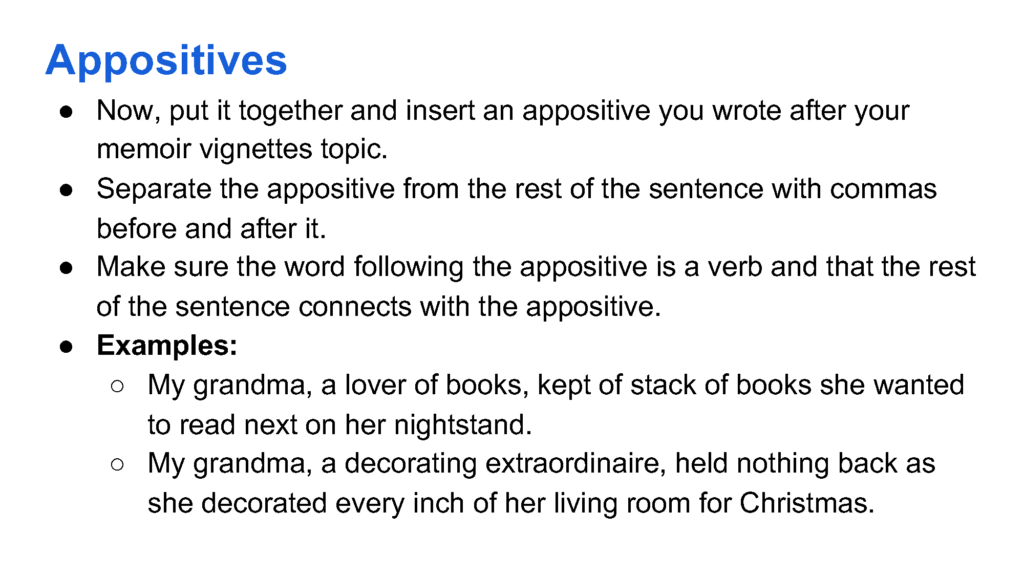
Day Two: Appositive Sentence Student Writing Practice
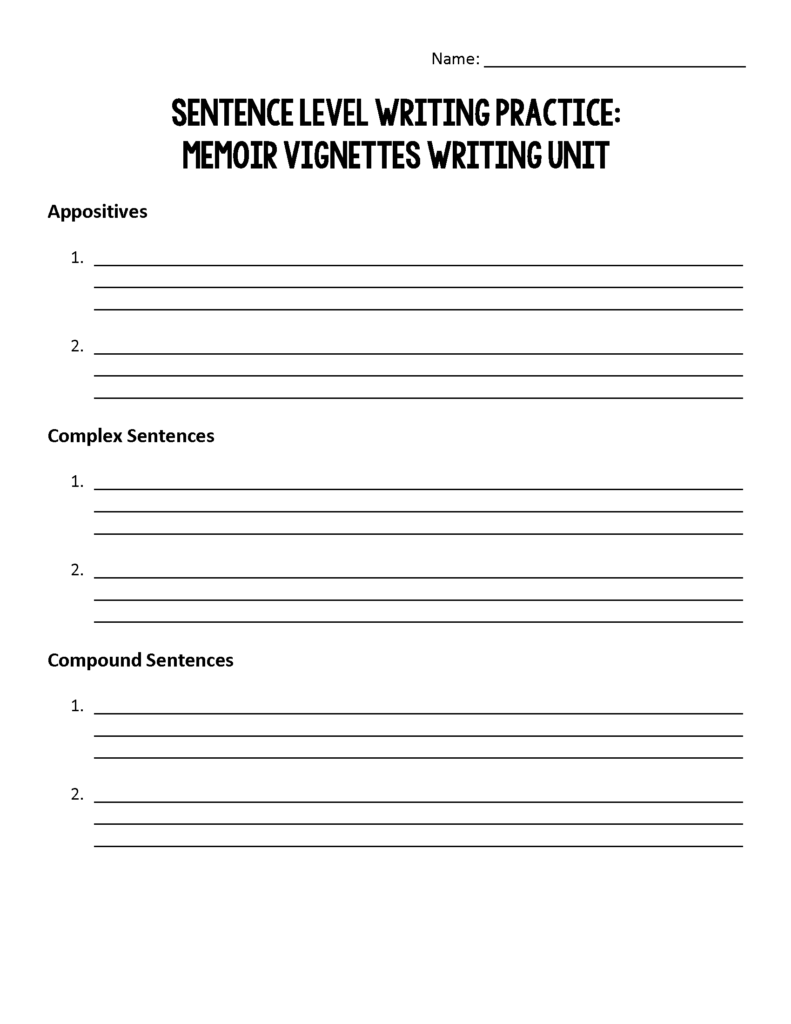
I alternate between sentence level writing instruction on a specific type of sentence and student practice of drafting sentences. Across every writing unit I teach, I circle back around to the same five types of sentences and have students practice drafting the different sentence types. Students are seeing example sentences specific to the genre of writing we are writing in for a particular writing unit, and students are drafting sentences specific to their topic within that writing unit. I do not require students to use the sentences they draft while practicing the different sentence types, but I definitely encourage them to keep their sentence sheet pictured above out during draft day in case they want to use a sentence or get inspiration from a sentence they’ve already drafted.
The 5-minutes of sentence level writing instruction throughout the rest of the writing unit looks like this. Once again, this is a class starter I use while teaching the writing unit using sentences from the mentor text from the writing unit:
Day Three: Complex Sentences
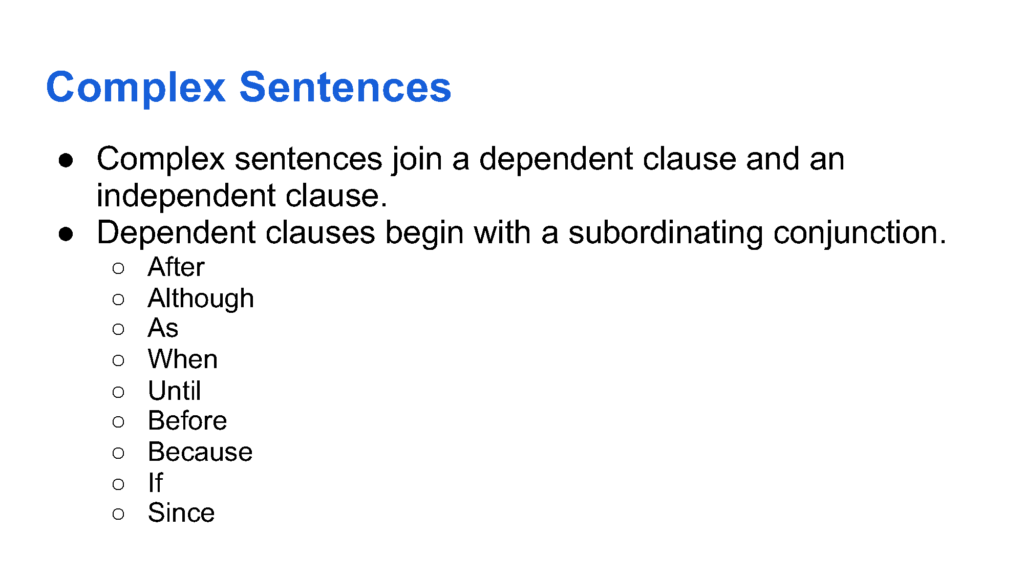
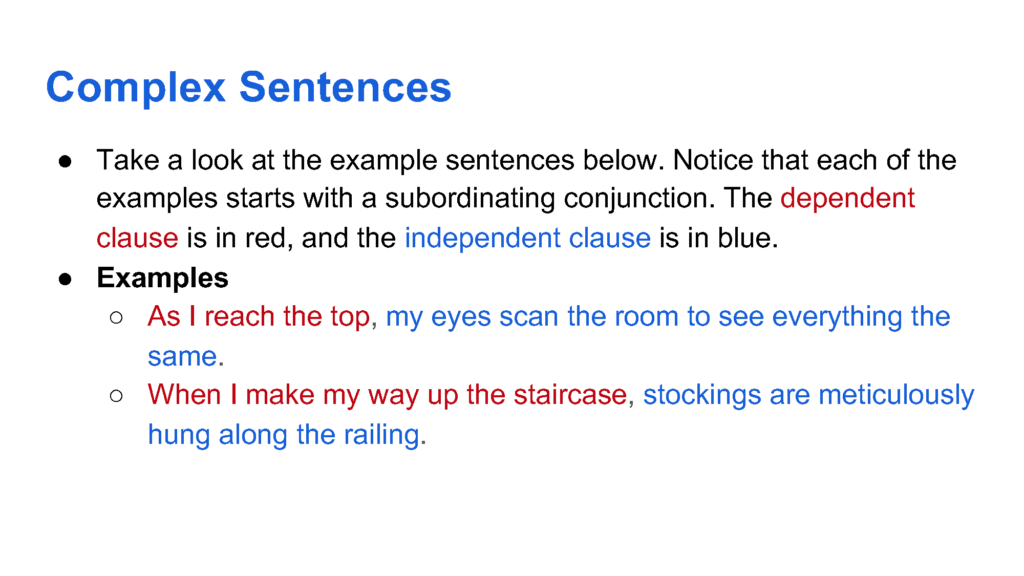
Day Four: Student Practice with Complex Sentences
Day Five: Compound Sentences
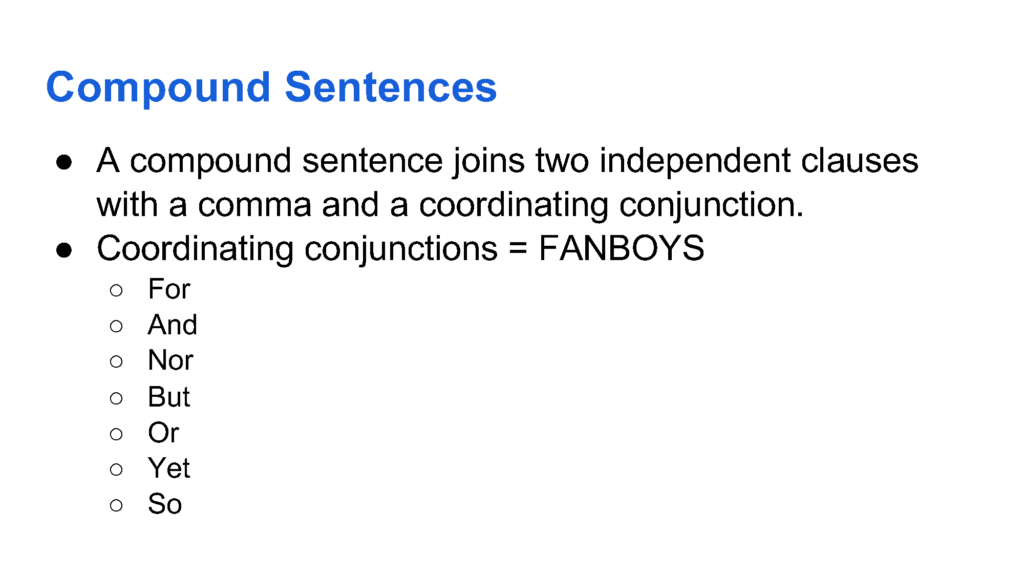
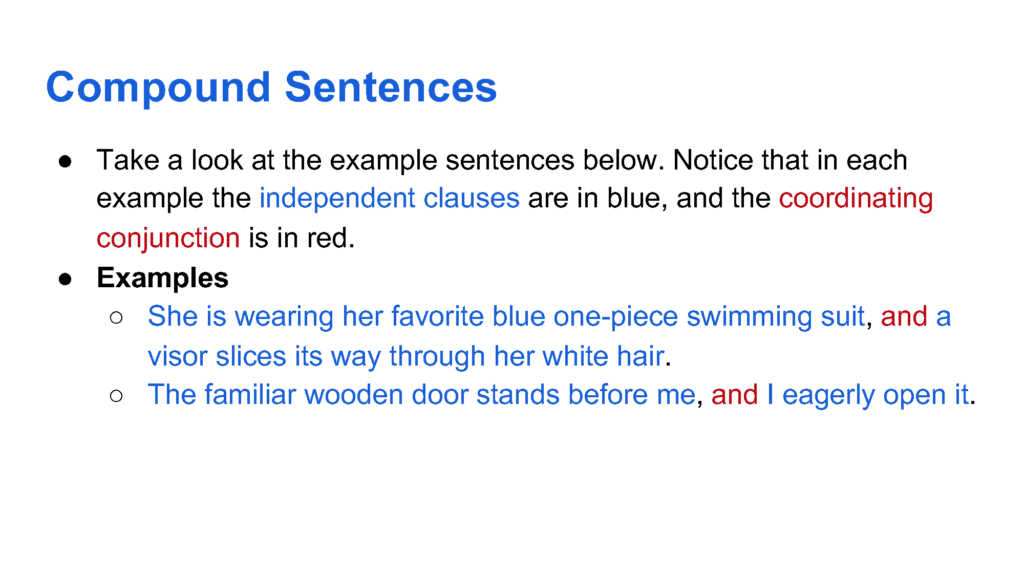
Day Six: Student Practice with Compound Sentences
Day Seven: Listing Items in a Series
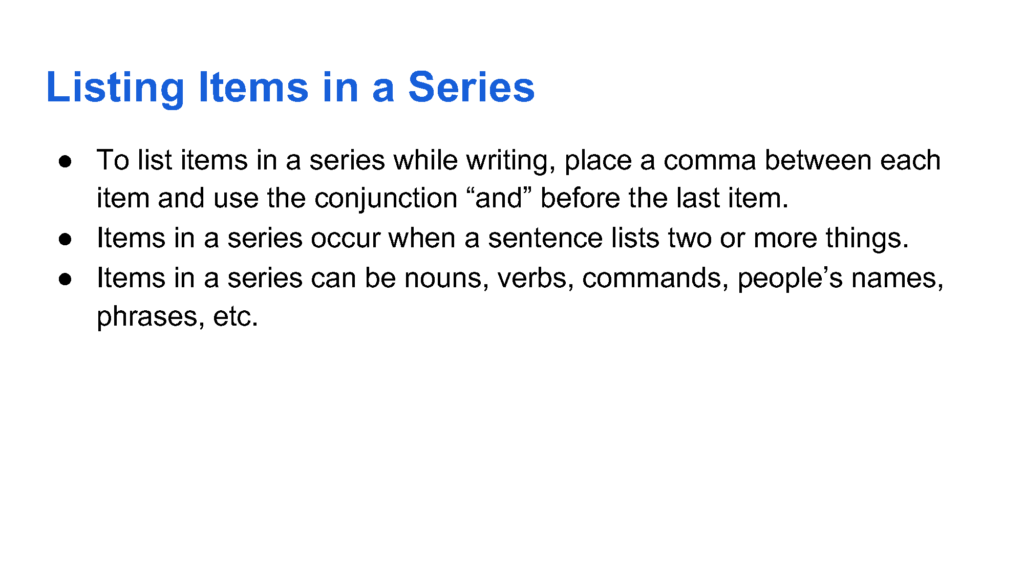

Day Eight: Student Practice with Listing Items in a Series
Day Nine: Two Adjectives, One Noun
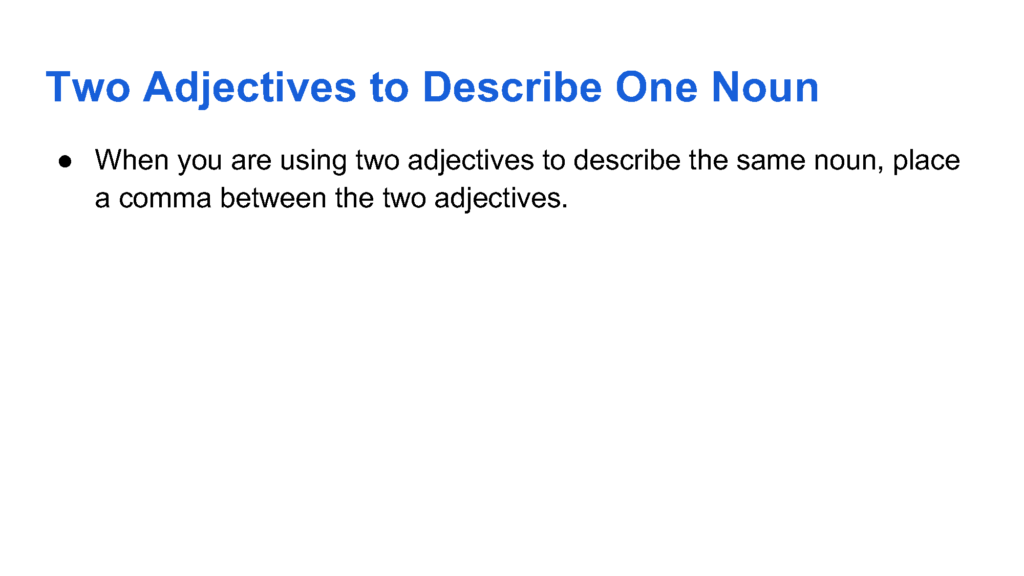
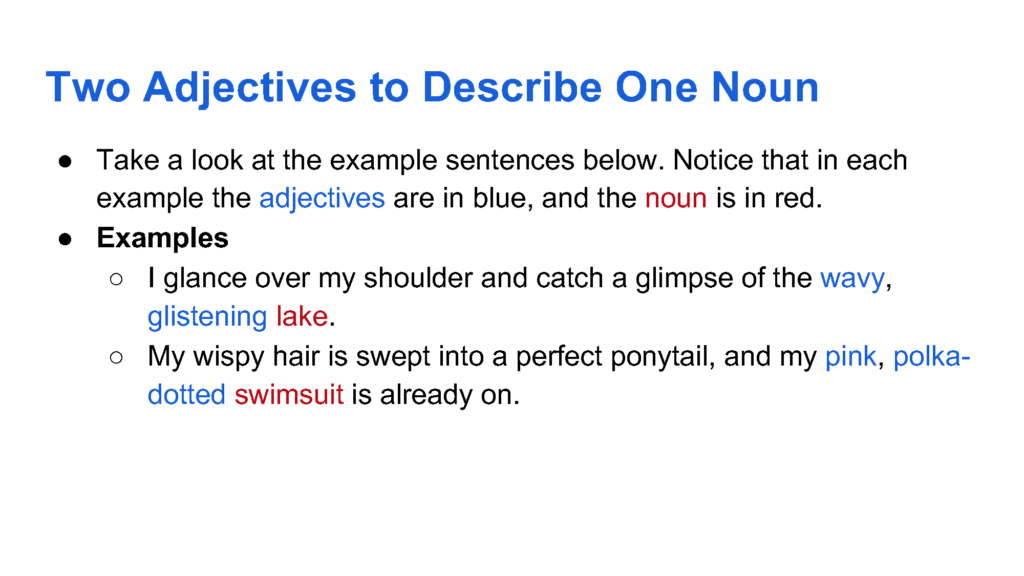
Day Ten: Student Practice with Two Adjectives, One Noun
Sentence level writing activities like the idea listed above have many benefits, especially if you consistently use sentence level writing activities during writing units.
- Give students an opportunity to practice writing different types of sentences independently.
- Make students confident in using different types of sentences beyond simple sentences through explicit instruction and trying it out together as a class.
- Help students understand the structure and conventions needed in different types of sentences.
- Have students rehearse different types of sentences in a low-stakes setting.
- To inspire students to use a variety of sentence types as they draft writing to help with sentence fluency and writing complexity.
- This instruction gives students a foundation in sentence level writing. It will improve students’ use of complete sentences while drafting writing. Additionally, it will create a common language for giving and receiving feedback around writing conventions.
I include sentence level writing activities like the activities pictured above for each of my ten writing units. The sentence examples of specific to the genre of the writing unit.
-Deleted Scene-Narrative Writing
-Blog Post-Informative/Explanatory Writing
-Product Review-Persuasive Writing
-Ask Anything-Research Writing
–Narrative Nonfiction-Narrative Writing Unit
–Literary Analysis-Informative/Explanatory Writing
–Important Issue Letter-Persuasive Writing
–Memoir Vignettes-Narrative Writing
–Quote to Live By-Informative/Explanatory Writing
–Book Recommendation-Persuasive Writing
Strategy Two: Have Students Count Their Sentences
I use this strategy all the time whether students are about to turn in a reading response or are editing a draft during a writing unit. I simply ask them to count the number of sentences in each paragraph of their writing. What does this do? Well, it makes the assumption that students have sentences to count as a start. If a student claims to only have one sentence in a reading response, but I look at their response and it looks like a paragraph of writing I might say something like, “Your response looks like it’s more than one sentence. See if you can go back through to find where your sentences start and stop.” Students get better at self-editing and fixing run-on sentences. I communicate the general rule that paragraphs should have between 4-8 sentences.
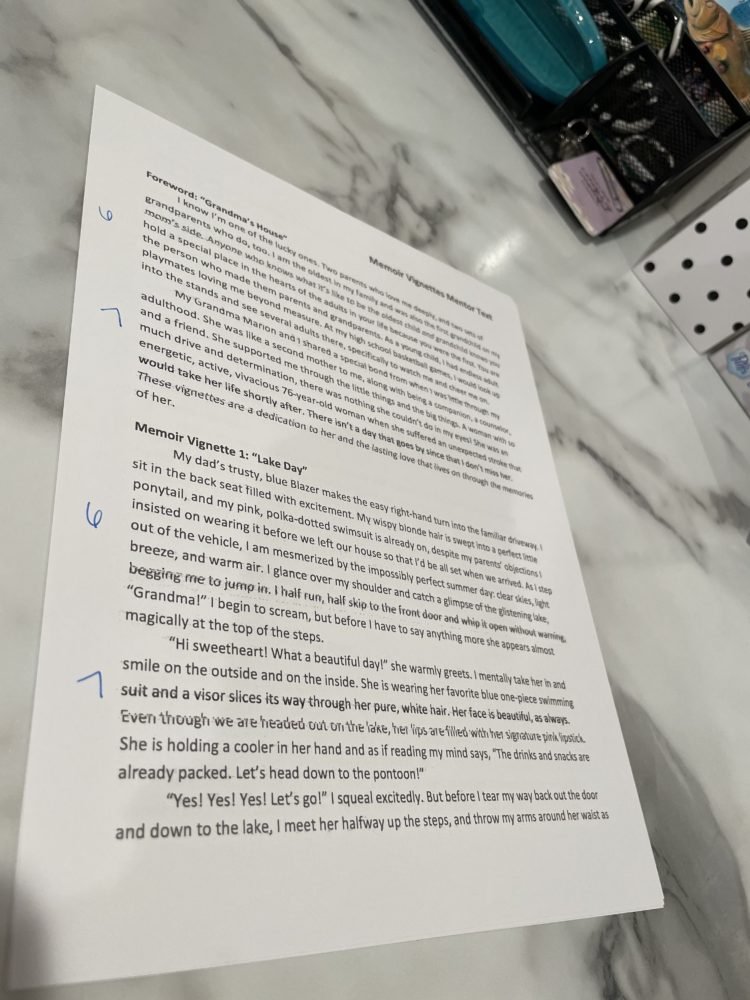
Strategy Three: Use Sentence Starters
Sentence starters are a great scaffold to use if you’re noticing that students aren’t using complete sentences in their writing or using low-quality sentences in their writing. Sentence fragments are often fragments because the sentence didn’t have a strong beginning. Giving students sentence starters for responding to literature or framing a paragraph in a writing piece gives them a foundation for a quality response. Some teachers worry that this is too much hand-holding or “giving students the answer.” Students are still coming up with the content and the thinking behind their response. What you’re doing is removing a barrier for students so they can be more successful. Below are two examples of how I use sentence starters in the middle school ELA classroom.
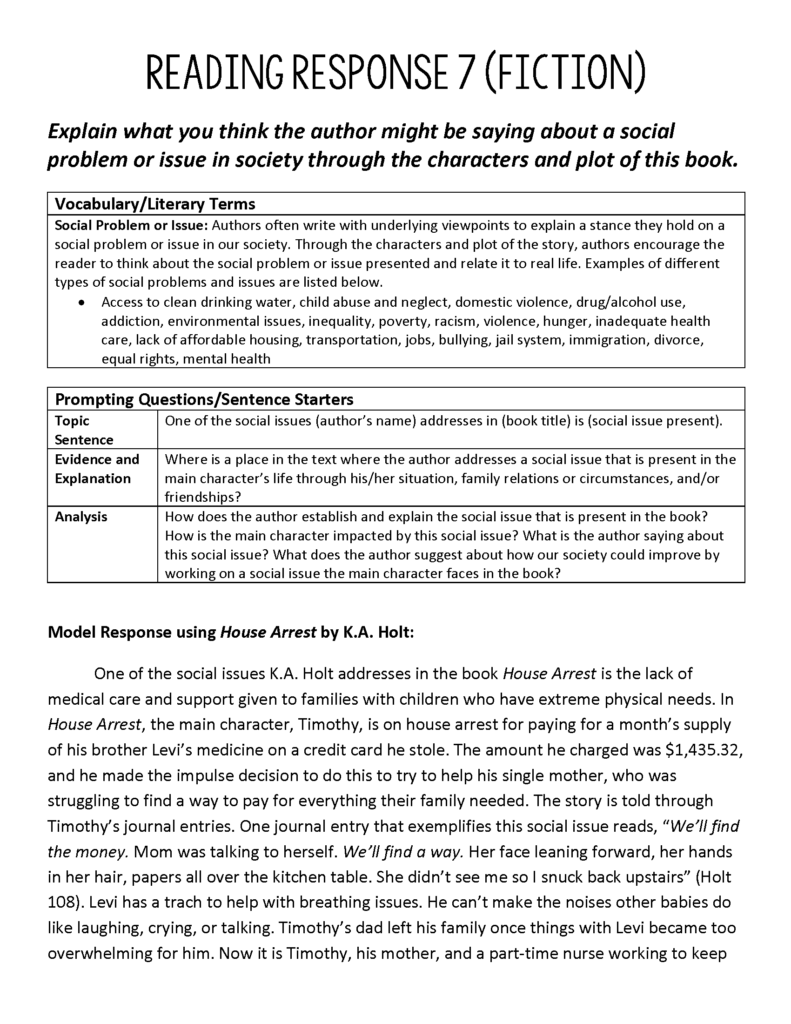
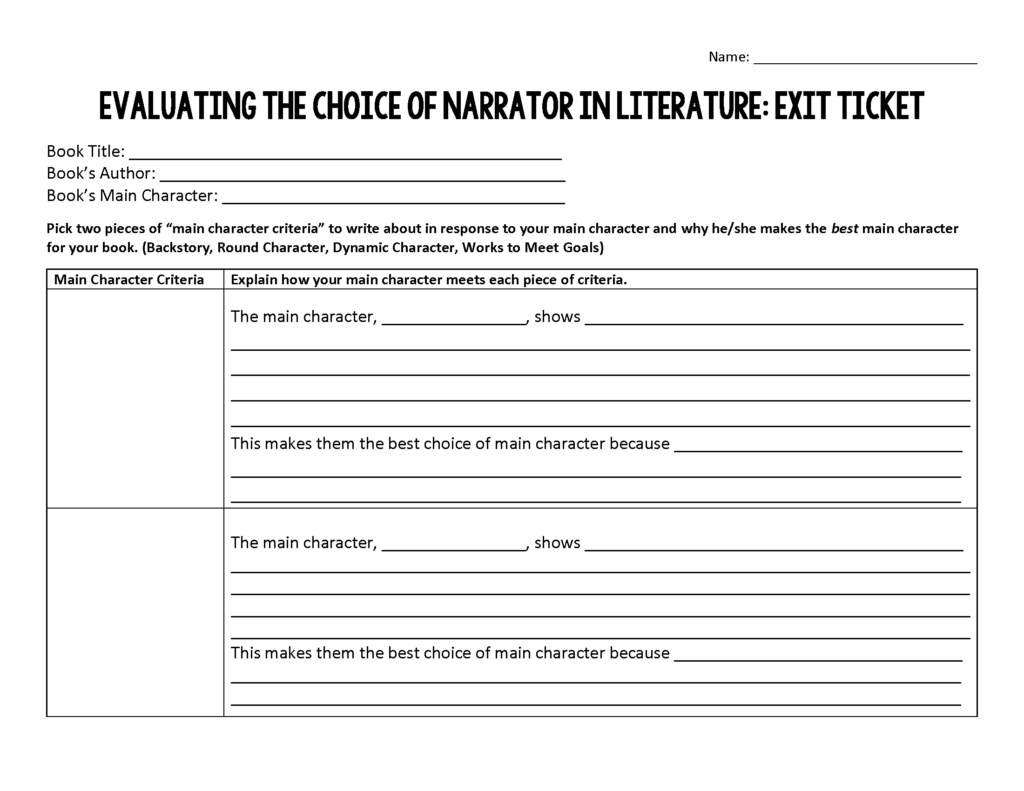
Strategy Four: Write Often and for a Variety of Purposes
How often do students write in your classroom? If you want students to get better at sentence-level writing and writing in general, they must have frequent opportunities to write for a variety of purposes. In my classroom, students write every single day. My curriculum alternates between reading units and writing units.
During writing units students are going through the writing process to get to a final draft in a specific genre of writing. As they’re going through the writing process, they are brainstorming, outlining, drafting, revising, editing, and publishing. I also incorporate sentence-level writing practice as mentioned in strategy one above.
During reading units, students complete a formative assessment daily in the form of an exit ticket. The exit tickets require short response to reading-based prompts and questions.
Writing looks different during reading units and writing units, but my standards for student writing remain high. Regardless if we’re in a reading unit or writing unit, I incorporate the following pieces whenever students complete writing:
-Mentor text based on the genre of writing students are writing in/modeling of reading response using our interactive read aloud text
-Editing checklist that students see again and again that is used as a reminder for convention expectation for ANY piece of writing. I have an anchor chart like the one pictured below up in my classroom and constantly refer to it.
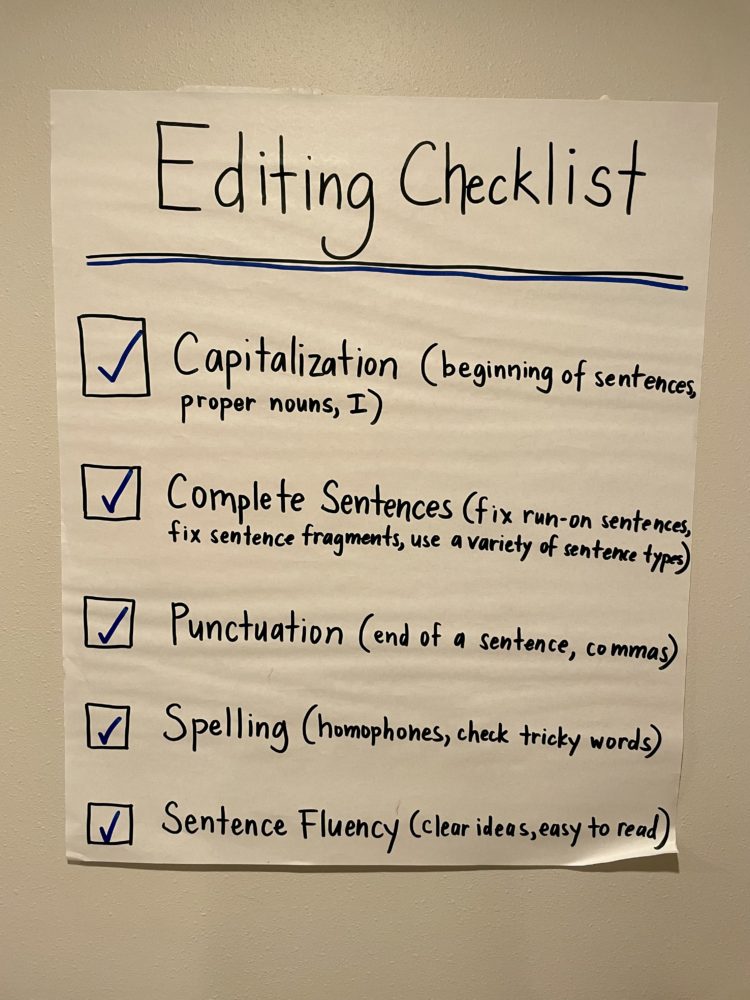
-Give students time to edit for writing conventions before submitting work for feedback and grading.
-Give feedback on writing conventions and expect students to make changes. I love using Google Classroom for this and giving suggestions to students about places to go back and fix. I don’t do this every single time or correct every single thing, but I do give consistent feedback on writing conventions.
Strategy Five: Survey Writing for Sentence Types
As a revising activity, ask students to go through a writing piece or a portion of a writing piece to identify what types of sentences are used. Give students a color to highlight simple sentences, a color for compound sentences, and a color for complex sentences. Once students have gone through their writing to identify the sentence types, give the following reflection questions:
-What type of sentence do I use the most often?
-Where is a place I need to revise to incorporate different sentence types?
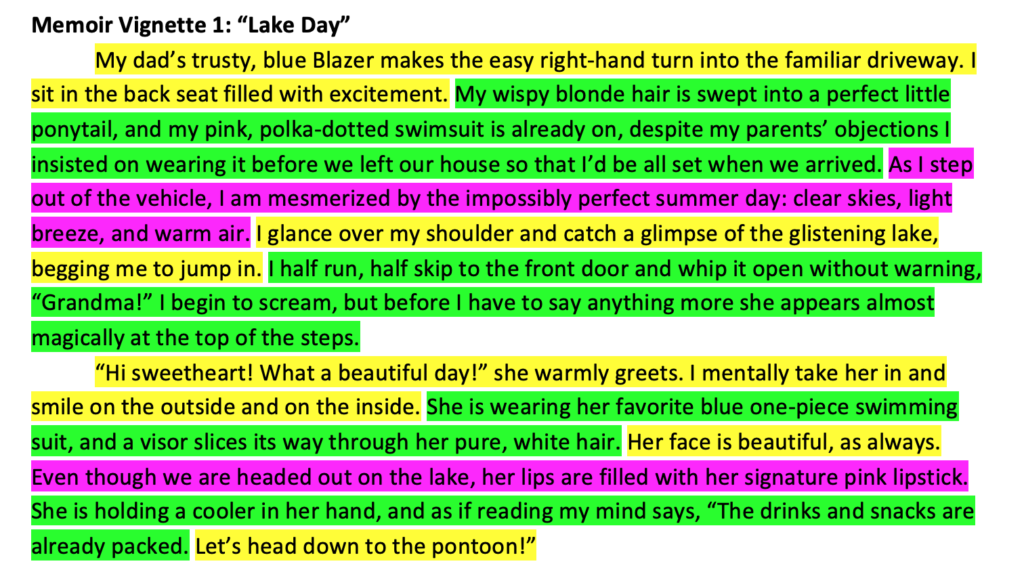
Strategy Six: Listen to Writing Aloud
We want students to write in complete sentences because it increases sentence fluency and clarity of ideas for readers. It’s important to keep this message consistent with students. We don’t focus on writing in complete sentences because we’re weird and mean English teachers. We focus on it because we want to help our students learn how to write with clarity so their ideas can be communicated with the world.
This strategy is as simple as having students read their writing aloud to a partner. Another way I’ve done this is to have students read their writing while using a screen recording app like Screencastify and then listen back to their reading. It also works with Google Docs when you turn on “Screen Reader Support” under “Tools” and “Accessibility Settings.” The computer will read your writing right to you.
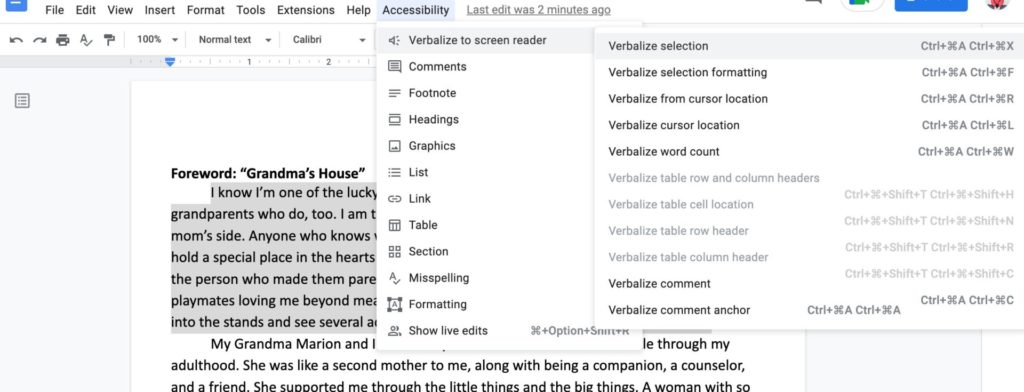
Strategy Seven: Focus Feedback on Sentences
I notice when I look at my own writing rubrics that the rubric contains 7-8 different pieces of grading criteria, and ONE of those pieces is “Writing Conventions” which encompasses using correct capitalization, punctuation, and spelling. My own rubric doesn’t direct me to give feedback to students on using complete, quality sentences. How do we expect students to improve on something we don’t give them feedback on? An even further question would be: How do we expect students to care about something that doesn’t even make the cut to be included on a rubric?
If students writing in complete, quality sentences is important to us, we must consider giving students feedback on how they’re doing with this. I’ve created a proficiency rubric to help give specific, measurable feedback on sentences in student writing. The rubric is based on students’ use of complete sentences, using commas correctly, using a variety of sentence types, and sentence fluency. For students who score “Approaches Proficiency,” “Minimal Proficiency,” or “No Evidence,” I’ve also built in “Next Steps” for quick and easy teacher feedback. You can view it below. If this is something you would like to use in your classroom, click here or on the image below to download this proficiency rubric for free.
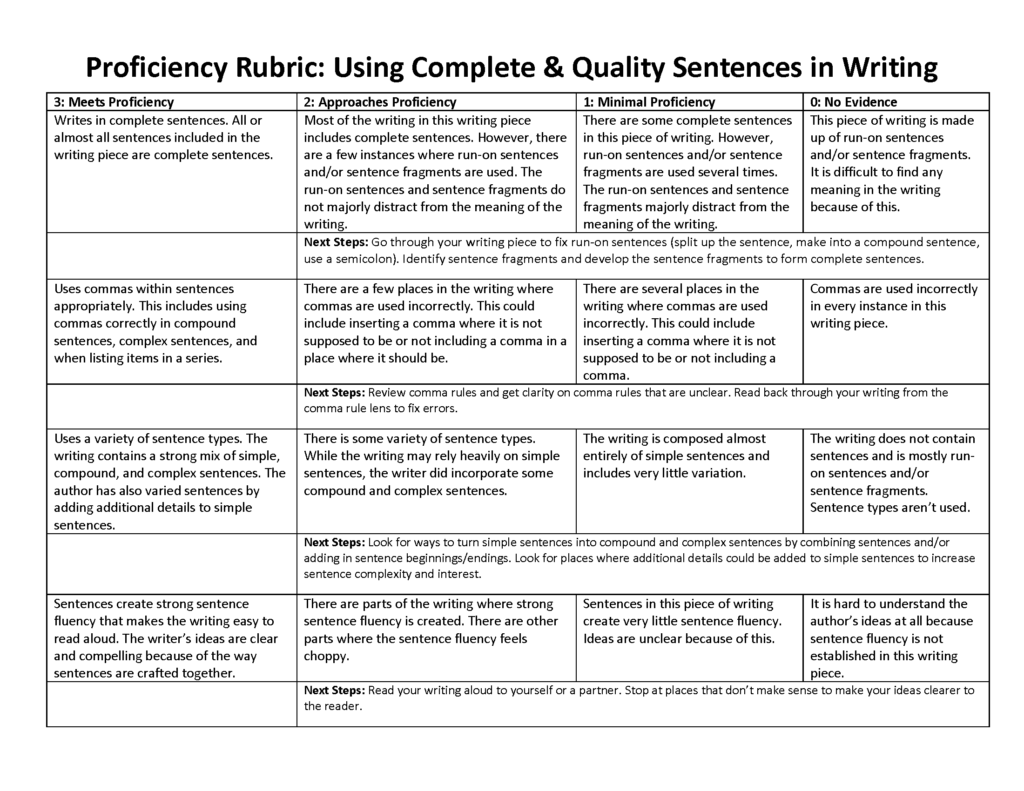
Final Thoughts
Of the seven strategies listed in this blog post, I hope at least one of them speaks to you and sparks an idea for how to help students create pieces of writing that contain complete, thoughtful sentences. If you’re looking for a middle school writing curriculum that incorporates many of the elements and strategies discussed above, consider checking out my 6-8 Year-Long Writing Curriculum.
~ Kasey





